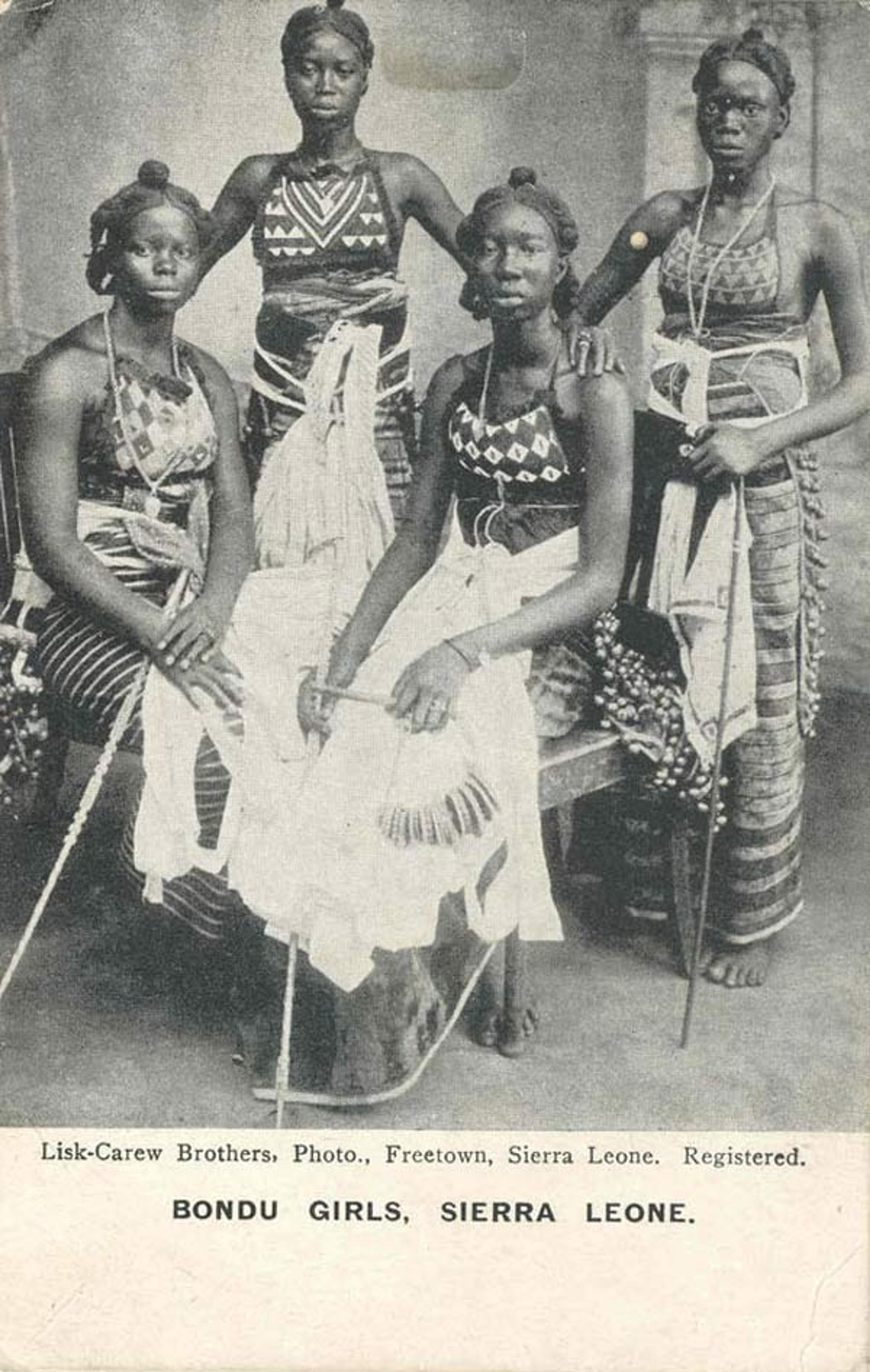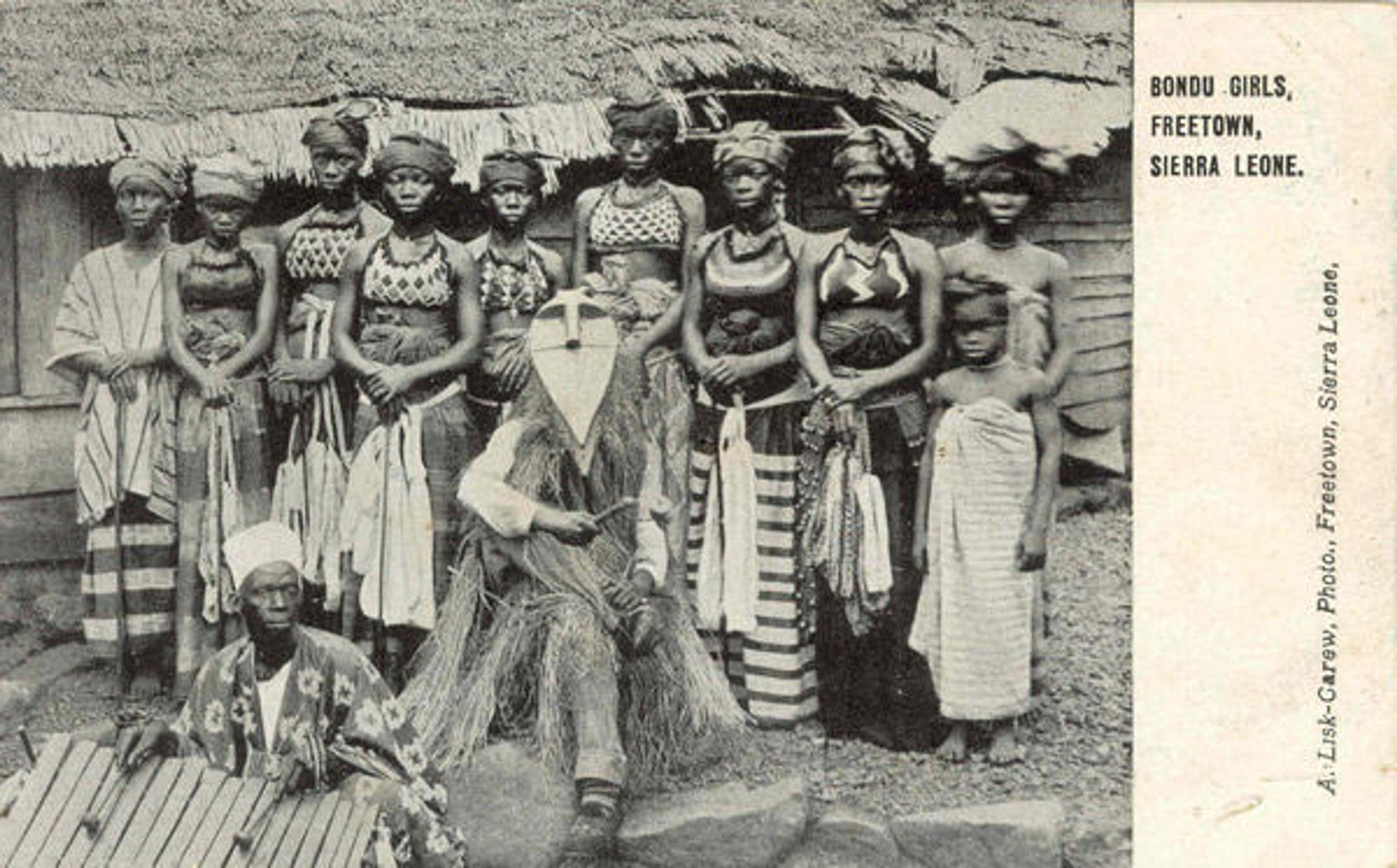Reinforcing Sierra Leonean Identity: Alphonso Lisk-Carew

Alphonso Lisk-Carew (Sierra Leonean, 1883–1969). Bundoo Girls, Sierra Leone, ca. 1905–1925. Photomechanical reproduction; 5 x 3 in. (13.3 x 8.3 cm). The Metropolitan Museum of Art, New York, Visual Resource Archives, Department of the Arts of Africa, Oceania, and the Americas (VRA.PC.AF.0002)
From Yaëlle Biro, Associate Curator for the Arts of Africa:
The exhibition In and Out of the Studio: Photographic Portraits from West Africa, open through January 3, includes approximately eighty photographs drawn from the Met's permanent collection. These negatives, vintage prints, and real-photo postcards will remain accessible to researchers through the Museum's Collection Online, or on-site, by appointment. Art historical approaches to photography from Africa are still in their infancy, and there is a lot to be explored. Here, specialist Julie Crooks uses one postcard from the exhibition to investigate photographs by Alphonso Lisk-Carew, a photographer from Sierra Leone active at the beginning of the twentieth century.
«Alphonso Lisk-Carew was a Sierra Leonean photographer whose practice was firmly rooted in the histories of Sierra Leone. Lisk-Carew's career spanned over fifty years, and his photography threw into sharp relief Sierra Leone's myriad local personalities, cityscapes, cultural practices, and natural resources. Through his lens, Lisk-Carew witnessed the development of Sierra Leone under the colonial regime, and became one amongst many early Sierra Leonean photographers who had a hand in shaping the country's history.»
Lisk-Carew's extant Bundu portraits make up a very small percentage of his vast body of images. His sophisticated and refined approach heightened the awareness of the Bundu cultural practice. Bundoo Girlswas taken between 1910 and 1911. In the staging of this tableau, Lisk-Carew used an elaborate painted backdrop featuring lush vegetation creeping along soaring Corinthian-style columns, elegant drapery, and a majestic Victorian-style stairway. The seated young woman clasps her hands in her lap, feet planted firmly on the ground. The woman standing to her right looks away from the camera, while the woman standing to her left offers a demure smile. Their costumes reflect the range of dress styles and adaptations in Bundu costuming and accessories that related to regional differences.
Bundu is a women's cultural society in the Upper Guinea coast region in Sierra Leone, Guinea, and Liberia that has been in existence since at least the seventeenth century. It is prevalent amongst Mende speakers along with the Temne, Sherbro, Vai, Lokko, and Susu groups. Though often called "secret," Bundu rituals are made up of both public manifestations and aspects in which the public is excluded. The Bundu society, is considered secret in that its rites and symbols, which are believed to retain special powers, are kept from noninitiates and all initiates are vowed to "secrecy."

Alphonso Lisk-Carew (Sierra Leonean, 1883–1969). Bondu Girls, Sierra Leone, ca. 1910–1911. Image courtesy of Christraud Geary
In Bundoo Girls and other portraits by Lisk-Carew, the symbolic elements found in the dress styles and ceremonial objects of the Bundu are tied together visually. Lisk-Carew has highlighted the modes of Bundu dress as unique to a social and cultural milieu. Within the Bundu society, attire is used to emphasize status differences between the initiated and the uninitiated.
While there are regional and cultural variants in graduation attire, the main identifying features consist of a short cotton halter-like top and a lappa, or wrap skirt, with or without a beaded attachment and a large piece of white cotton fabric draped and knotted in the front. The tamboria, or head tie, is associated with the Susu costume, but absent among the Temne- and Mende-speaking groups. The various stages of Bundu, both secret and public, shared similarities, but were also subject to regional adaptations, which created a range of attire, costumes, and accoutrements.

Alphonso Lisk-Carew (Sierra Leonean, 1883–1969). Bondu Girls, Freetown, Sierra Leone, ca. 1903–1905. Cambridge University Library: Royal Commonwealth Society Library, James Carmichael Smith Sierra Leone Collection
The Bundu women became a particular subject of interest for fascinated western observers such as European photographers and their overseas consumers. Local African photographers also exploited the opportunity to photograph the Bundu women, and the images they produced gained popularity as commodities in the form of postcards. The portraits served as visual expressions of social mobility, as they often signified the ability of wealthy families to afford a portrait taken by one of Freetown's most established Creole photographers.
Membership in Bundu provided a lifelong solidarity, which assisted in offering both spiritual and cultural refuge, and a platform to encourage loyalty to cultural practices. Alphonso Lisk-Carew's carefully deployed Bundu portraits helped to define and reinforce national and local identities.
Further Reading
Arden-Boone, Sylvia. Radiance from the Water: Ideals of Feminine Beauty in Mende Art. New Haven: Yale University Press, 1981.
Crooks, Julie. "Alphonso Lisk-Carew: Imaging Sierra Leone Through his Lens." In African Arts vol. 48, no. 3 (2015): 18–27.
Geary, Christraud. "Different Visions? Postcards from Africa by European and African Photographers and Sponsors." In Delivering Views: Distant Cultures in Early Postcards, edited by Christraud Geary and Virginia Lee-Webb. Washington, D.C.: Smithsonian Institution, 1998.
Geary, Christraud. "The Black Female Body, the Postcard, and the Archives." In Black Womanhood: Images, Icons, and Ideologies of the African Body, edited by Barbara Thompson. Hanover: Hood Museum of Art, Dartmouth College; Seattle: University of Washington Press, 2008.
Hendrickson, Hildi. "Introduction." In Clothing and Difference: Embodied Identities in Colonial and Postcolonial Africa. Durham: Duke University Press, 1996.
Phillips, Ruth. Representing Woman: Sande Masquerades of the Mende of Sierra Leone. Los Angeles: Fowler Museum of Art, 1991.
Richards, J.V.O. "Some Aspects of the Multivariant Socio-Cultural Roles of the Sande of the Mende." In Canadian Journal of African Studies vol. 9, no. 100 (1975): 103–104.
Julie Crooks
Guest blogger Julie Crooks is a Rebanks Post Doctoral Fellow at the Royal Ontario Museum.